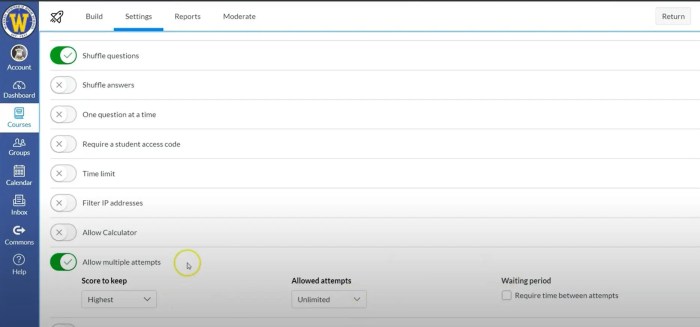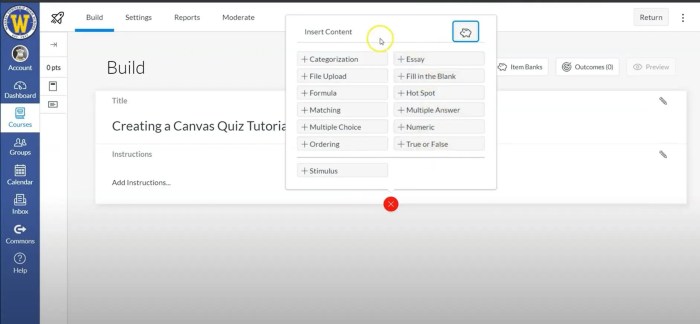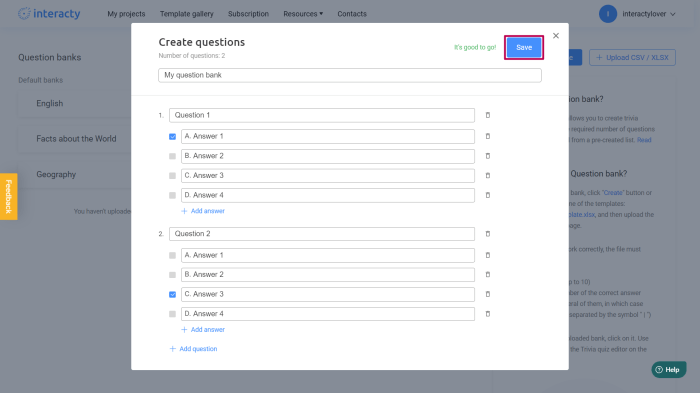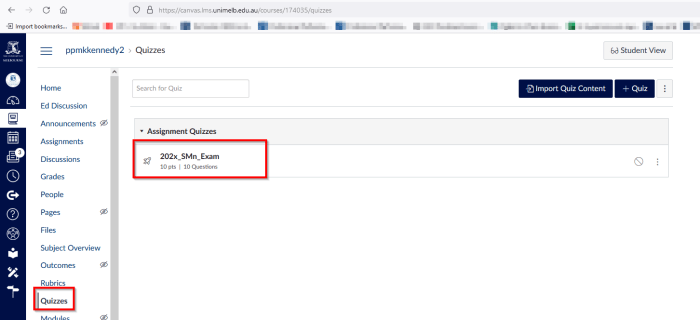How to establish a question bank on Canvas is a crucial skill for educators seeking to streamline assessment creation and enhance the learning experience. This guide provides a comprehensive walkthrough, from understanding Canvas’s question bank features to implementing advanced strategies for effective assessment design and management. We’ll explore various question types, best practices for question writing, and methods for organizing and utilizing your question bank efficiently.
By the end, you’ll be equipped to build a robust and adaptable question bank that supports your teaching goals.
Creating a well-organized question bank in Canvas offers significant advantages. It allows for the efficient reuse of questions across multiple assessments, saving valuable time and effort. Furthermore, it facilitates the creation of varied assessment versions, reducing the likelihood of cheating and promoting fairness. This guide will empower you to leverage these benefits, transforming your assessment process and enhancing the overall quality of your teaching.
Understanding Canvas Features for Question Banks

Canvas offers robust tools for creating and managing question banks, significantly enhancing the efficiency and effectiveness of assessments. This section will guide you through the various question types, the process of creating and populating question banks, and a comparison of the features of each question type.
Canvas Question Types
Canvas provides a variety of question types to suit diverse assessment needs. Understanding the strengths and limitations of each type is crucial for creating effective and engaging assessments. The available question types allow for varied testing methods, ensuring a comprehensive evaluation of student understanding. Each question type offers unique features and functionalities that can be tailored to specific learning objectives.
Creating a New Question Bank in Canvas
Creating a new question bank is a straightforward process. First, navigate to the course in which you wish to create the question bank. Then, access the “Quizzes” section within your course navigation. Select “Question Banks” from the options provided. Click on the “+ Question Bank” button to initiate the creation of a new question bank.
You will be prompted to provide a name for your question bank; this name should be descriptive and easily identifiable. Once named, click “Create” to finalize the creation of your new question bank.
Importing Questions into an Existing Question Bank
Importing questions into an existing question bank streamlines the process of populating your assessment resources. Begin by navigating to the “Question Banks” section within your course’s Quizzes area. Select the question bank into which you wish to import questions. Look for the “Import Questions” option; this will typically be a button or a link. You’ll then have the option to import questions from various sources, such as a CSV file or from another Canvas course.
Follow the on-screen instructions to complete the import process. Ensure your import file is correctly formatted to avoid errors.
Comparison of Question Types
The following table compares the features and limitations of different question types available within Canvas.
| Question Type | Features | Limitations | Best Suited For |
|---|---|---|---|
| Multiple Choice | Easy to grade, allows for various levels of difficulty | Can promote guessing, may not assess deeper understanding | Testing factual knowledge, quick assessments |
| True/False | Simple and quick to answer, easy to grade | Highly susceptible to guessing, limited in assessing understanding | Basic knowledge checks, quick quizzes |
| Fill in the Blank | Allows for more open-ended responses than multiple choice | Can be challenging to grade consistently, potential for ambiguity | Assessing knowledge recall, short answer questions |
| Essay | Allows for in-depth responses, assesses critical thinking | Time-consuming to grade, subjective grading potential | Assessing higher-order thinking skills, complex analysis |
Building Effective Questions for Your Bank: How To Establish A Question Bank On Canvas

Creating a robust question bank requires careful consideration of question types and their ability to assess student understanding effectively. A well-designed bank uses diverse question formats to gauge various levels of comprehension, from basic recall to higher-order thinking skills. This section will explore best practices for crafting effective multiple-choice, true/false, short answer, and essay questions.
Multiple-Choice Questions
Multiple-choice questions are versatile and easily graded. However, creating effective ones requires careful consideration of the correct answer and the distractors (incorrect options). Distractors should be plausible and tempting to students who haven’t fully grasped the concept. Below are five examples focusing on the topic of photosynthesis:
- Question: Which of the following is the primary pigment involved in photosynthesis?
Correct Answer: Chlorophyll a
Distractors: Chlorophyll b, Carotenoid, Xanthophyll - Question: What is the primary product of the light-dependent reactions of photosynthesis?
Correct Answer: ATP and NADPH
Distractors: Glucose, Oxygen, Carbon Dioxide - Question: Where does the Calvin cycle take place within a plant cell?
Correct Answer: Stroma
Distractors: Thylakoid membrane, Cytoplasm, Nucleus - Question: What is the role of water in photosynthesis?
Correct Answer: Provides electrons to replace those lost by chlorophyll
Distractors: Provides carbon for glucose synthesis, Acts as an energy source, Is a byproduct of the process - Question: Which of the following factors can limit the rate of photosynthesis?
Correct Answer: Light intensity, carbon dioxide concentration, temperature
Distractors: Oxygen concentration, soil pH, rainfall
True/False Questions
True/false questions are efficient for assessing basic knowledge recall. However, ambiguity must be avoided. Effective true/false questions are concise and focus on a single concept. Avoid using qualifiers like “always,” “never,” or “all,” which can make a statement false even if it’s mostly true. Instead, focus on factual statements that are either demonstrably true or false.
For example, instead of “Photosynthesis always occurs during daylight hours,” a better question would be “Photosynthesis requires light energy.”
Short Answer Questions
Short answer questions encourage more detailed responses than true/false questions, promoting deeper engagement with the material. To foster critical thinking, frame questions that require analysis, interpretation, or application of knowledge. For example, instead of asking “What is photosynthesis?”, a more effective question would be “Explain how the light-dependent and light-independent reactions of photosynthesis are interconnected.” Another example could be “Compare and contrast C3 and C4 photosynthesis, highlighting their adaptations to different environments.” These prompts require students to synthesize information and demonstrate understanding beyond simple recall.
Essay Questions
Essay questions are ideal for assessing higher-order thinking skills such as analysis, synthesis, and evaluation. To ensure high quality, design essay questions that are focused, clear, and require more than just simple summarization. The prompt should clearly indicate the desired depth of response and the specific aspects of the topic to be addressed. For example, instead of “Discuss photosynthesis,” a more effective question would be “Analyze the impact of climate change on photosynthetic rates in different plant species, considering the roles of temperature, CO2 levels, and water availability.” Another strong example is “Evaluate the economic and environmental implications of developing alternative energy sources based on photosynthetic processes.” Providing specific guiding questions or sub-points within the essay prompt can further enhance the clarity and focus of the responses.
Managing and Organizing Your Question Bank

A well-organized question bank is crucial for efficient assessment creation and management within Canvas. Effective organization ensures easy retrieval of questions, reduces redundancy, and streamlines the process of updating or modifying your assessment materials. This section will guide you through strategies for categorizing, searching, editing, and maintaining your question bank to maximize its utility.
Categorizing and Tagging Questions
Organizing your question bank using categories and tags allows for efficient retrieval of specific question types or topics. Categories might reflect broad subject areas (e.g., “Chapters 1-5,” “Thermodynamics,” “Renaissance Art”). Tags, on the other hand, can provide more granular detail, such as “multiple choice,” “difficult,” “application-based,” or “requires graphing calculator.” Canvas allows for the assignment of multiple categories and tags to each question, facilitating flexible searching and filtering.
For instance, a question might be categorized under “Chapter 3” and tagged as “multiple choice,” “easy,” and “conceptual.” This detailed tagging enables quick selection of questions suitable for specific assessment types or learning objectives. Consistent and descriptive categorization and tagging are key to maximizing the effectiveness of this system.
Searching and Filtering Questions, How to establish a question bank on canvas
Canvas provides robust search and filtering capabilities within the question bank. You can search for questions using s within the question text, answers, or feedback. More advanced filtering options allow you to narrow your search by question type (multiple choice, true/false, essay, etc.), difficulty level (if tagged accordingly), and assigned categories and tags. For example, searching for “Newton’s Laws” and filtering by “application-based” and “difficult” will quickly return only those questions matching these criteria.
Effective use of these features saves considerable time when constructing assessments.
Editing and Updating Questions
Editing and updating questions within your question bank is straightforward in Canvas. Simply navigate to the question you wish to modify, make the necessary changes (e.g., correct typos, update answer choices, adjust difficulty level), and save your changes. Canvas automatically updates the question across all assessments where it is used. Regularly reviewing and updating your question bank is essential to maintain accuracy and relevance.
This includes checking for outdated information, ambiguous wording, or questions that may no longer align with your course objectives.
Maintaining a Large Question Bank
Managing a large question bank can present challenges. One common issue is the potential for inconsistencies or redundancies. To mitigate this, consider implementing a regular review process, perhaps annually or at the end of each semester. This review should focus on identifying outdated questions, removing duplicates, and ensuring that the categorization and tagging remain consistent and relevant.
Another helpful strategy is to assign different individuals responsibility for maintaining specific sections or categories of the question bank, facilitating collaboration and distributing the workload. Regular backups of your question bank are also recommended to protect against data loss.
Utilizing Question Banks in Assessments

Now that you’ve built your question bank, let’s explore how to effectively utilize it within your Canvas assessments. This section will guide you through integrating your questions, assigning points, creating variations of your assessments, and shuffling questions for enhanced assessment integrity.
Integrating your carefully crafted question bank into quizzes and assignments in Canvas is straightforward and offers significant benefits in terms of efficiency and assessment variation. The process leverages Canvas’s built-in functionality to seamlessly draw questions from your pre-prepared bank, saving you considerable time and effort while ensuring consistent assessment quality.
Inserting Questions from the Question Bank
To insert questions from your question bank into a quiz or assignment, navigate to the assessment’s editing page. You’ll find an option to add questions; within this section, select “Question Bank.” A list of your available question banks will appear. Choose the relevant bank, and you’ll then be presented with the questions within that bank. Select the specific questions you want to include in your assessment.
Canvas allows for multiple selections, enabling you to easily build your assessment from your existing question pool.
Assigning Points and Weighting Questions
Once you’ve selected questions from your bank, Canvas provides a simple interface to assign points to each question. This allows for weighting questions according to their difficulty or importance. For instance, a more complex problem-solving question might be worth more points than a simple multiple-choice question. You can adjust the point value for each question individually, providing flexibility in your assessment design.
The total points for the assessment will automatically update as you modify individual question point values. This ensures accuracy and transparency in your assessment scoring.
Creating Different Versions of an Assessment
Question banks are invaluable for creating multiple versions of an assessment. This is crucial for minimizing cheating and ensuring assessment fairness. By selecting different questions from your bank for each version, you can generate unique assessments while maintaining consistent content coverage. Canvas allows you to easily create multiple quizzes or assignments, each drawing from the same question bank but with different question selections.
This is particularly useful for large classes where the risk of academic dishonesty is higher. For example, you could create three versions of a midterm exam, each drawing 10 questions randomly from a question bank of 30 questions, ensuring no two students have the same exam.
Shuffling Questions within an Assessment
To shuffle questions within an assessment using your question bank, locate the settings for your quiz or assignment. Canvas offers a simple checkbox or dropdown menu that allows you to enable question shuffling. This feature randomly reorders the questions within the assessment for each student. This simple yet effective strategy significantly reduces the likelihood of students copying answers from their peers.
Enabling this option will automatically randomize the order of questions selected from your question bank for each student taking the assessment. The point values assigned to each question remain unchanged, regardless of their position in the shuffled order.
Advanced Features and Considerations

Leveraging Canvas question banks extends beyond basic assessment creation; understanding advanced features and their implications is crucial for maximizing their effectiveness and ensuring fair and reliable evaluations. This section explores key considerations regarding adaptive assessments, accessibility, cheating prevention, and maintaining question bank relevance.
Adaptive Assessments
Utilizing question banks allows for the creation of adaptive assessments, which personalize the testing experience based on student performance. This dynamic approach adjusts the difficulty and content of subsequent questions based on a student’s answers to previous ones. For example, if a student consistently answers easy questions correctly, the assessment might present more challenging questions to gauge their deeper understanding.
Conversely, if a student struggles, the assessment may offer simpler questions or provide hints to support their learning. This method offers a more precise evaluation of student knowledge and provides valuable insights into individual learning needs. Adaptive assessments, therefore, lead to more efficient and targeted testing, reducing testing time while providing a more accurate reflection of student capabilities.
Accessibility and Inclusivity
Designing accessible and inclusive assessments is paramount. Question banks facilitate this by allowing instructors to easily modify question formats and add alternative text descriptions for images and multimedia. For example, providing multiple choice options alongside fill-in-the-blank questions caters to different learning styles and abilities. Incorporating text-to-speech functionality and screen reader compatibility ensures students with visual impairments can access the assessment.
Furthermore, using clear and concise language, avoiding jargon, and providing sufficient time for completion promotes inclusivity and reduces barriers to participation. By carefully considering accessibility features during question bank creation, instructors can create equitable and inclusive assessment experiences for all learners.
Preventing Cheating and Ensuring Assessment Integrity
Maintaining assessment integrity is vital when using question banks. Canvas offers several features to mitigate cheating. Random question selection ensures that each student receives a unique set of questions from the bank, reducing the likelihood of students sharing answers. Time limits and IP address tracking can further enhance security. Furthermore, employing question types that are less susceptible to memorization, such as essay questions or problem-solving tasks, reduces the effectiveness of rote memorization and collusion.
Regularly reviewing and updating the question bank also helps prevent students from accessing outdated or previously circulated questions. A robust approach combining various Canvas features and careful question design is crucial for maintaining the integrity of assessments utilizing question banks.
Regular Review and Update Workflow
A structured workflow is essential for maintaining the accuracy and relevance of questions within the question bank. This should include regular review cycles, ideally at the end of each academic term or semester. The review process should involve evaluating the performance of each question (e.g., difficulty level, discrimination index), identifying outdated or inaccurate content, and updating questions based on changes in curriculum or research findings.
A collaborative approach, involving colleagues or teaching assistants, can ensure a comprehensive review. This process should be documented to track changes and maintain a clear audit trail. By incorporating regular updates, instructors ensure the question bank remains a reliable and effective tool for assessment.
Closing Notes

Establishing a question bank on Canvas is an investment in efficient and effective assessment design. By following the steps Artikeld in this guide, you can create a robust resource that streamlines your workflow, promotes assessment integrity, and ultimately enhances the learning experience for your students. Remember to regularly review and update your question bank to maintain accuracy and relevance, ensuring its continued value as a teaching tool.
Embrace the possibilities of organized assessment and witness the positive impact on your teaching and your students’ learning.